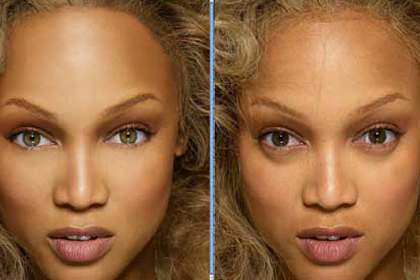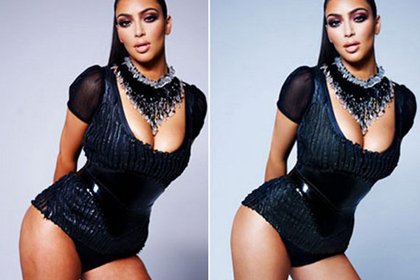Dear Photo Editors: The jig is up. People are onto you and your maniacal ways. So, what do you say you step away from the Photoshop stylus so we can talk?
Attaboy.
For years, we avid consumers of media have feasted upon your offerings of the beautiful people. Countless photos of an ageless Madonna, a svelte Tyra Banks, a flawless J. Lo have seeped into our collective consciousness and done a major number on our self-esteem.
 You've been chided in the past for brushing and tweaking images of genetically blessed, bronzed, Amazonian models to levels of ridiculous perfection -- but did that stop you? Ha.
You've been chided in the past for brushing and tweaking images of genetically blessed, bronzed, Amazonian models to levels of ridiculous perfection -- but did that stop you? Ha.
You put stars' heads onto other people's bodies, whittle away at waistlines, re-position hands and legs to near contortionist proportions all the while hiding behind the claim that it's "art" and that people want to see "perfect images."
Guess what? We don't. And, we're not alone.
In fact, this problem has reached such epic proportions that in June, the American Medical Association asked advertisers to "discourage the altering of photographs in a manner that could promote unrealistic expectations of appropriate body image." Legislators in Europe and America are so annoyed that they're calling for doctored photos to be clearly identified as such. And now, according to the "New York Times," a couple of computer science geniuses at Dartmouth are, "proposing a software tool for measuring how much fashion and beauty photos have been altered, a 1-to-5 scale that distinguishes the infinitesimal from the fantastic."
 Such a tool would help make inroads towards exposing altered photos for what they really are -- fantasy. And, if it was made accessible to the public, just think how much fun it would be to play around with. You could use it on photos of your favorite celebs and see just how much Photoshopping it took to get them to look so darn good.
Such a tool would help make inroads towards exposing altered photos for what they really are -- fantasy. And, if it was made accessible to the public, just think how much fun it would be to play around with. You could use it on photos of your favorite celebs and see just how much Photoshopping it took to get them to look so darn good.
Now I know what I want for Christmas.
Attaboy.
For years, we avid consumers of media have feasted upon your offerings of the beautiful people. Countless photos of an ageless Madonna, a svelte Tyra Banks, a flawless J. Lo have seeped into our collective consciousness and done a major number on our self-esteem.
 You've been chided in the past for brushing and tweaking images of genetically blessed, bronzed, Amazonian models to levels of ridiculous perfection -- but did that stop you? Ha.
You've been chided in the past for brushing and tweaking images of genetically blessed, bronzed, Amazonian models to levels of ridiculous perfection -- but did that stop you? Ha.
You put stars' heads onto other people's bodies, whittle away at waistlines, re-position hands and legs to near contortionist proportions all the while hiding behind the claim that it's "art" and that people want to see "perfect images."

Guess what? We don't. And, we're not alone.
In fact, this problem has reached such epic proportions that in June, the American Medical Association asked advertisers to "discourage the altering of photographs in a manner that could promote unrealistic expectations of appropriate body image." Legislators in Europe and America are so annoyed that they're calling for doctored photos to be clearly identified as such. And now, according to the "New York Times," a couple of computer science geniuses at Dartmouth are, "proposing a software tool for measuring how much fashion and beauty photos have been altered, a 1-to-5 scale that distinguishes the infinitesimal from the fantastic."
 Such a tool would help make inroads towards exposing altered photos for what they really are -- fantasy. And, if it was made accessible to the public, just think how much fun it would be to play around with. You could use it on photos of your favorite celebs and see just how much Photoshopping it took to get them to look so darn good.
Such a tool would help make inroads towards exposing altered photos for what they really are -- fantasy. And, if it was made accessible to the public, just think how much fun it would be to play around with. You could use it on photos of your favorite celebs and see just how much Photoshopping it took to get them to look so darn good.
Now I know what I want for Christmas.

